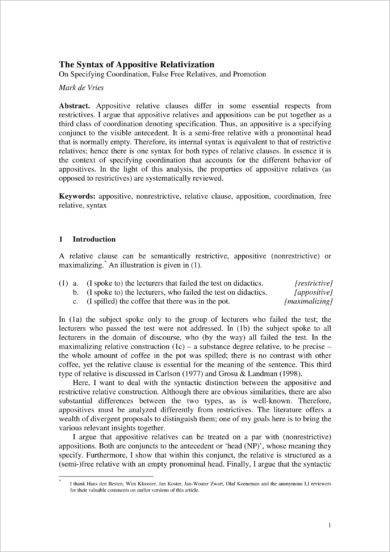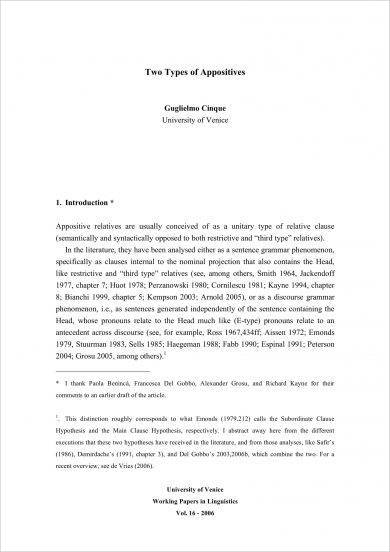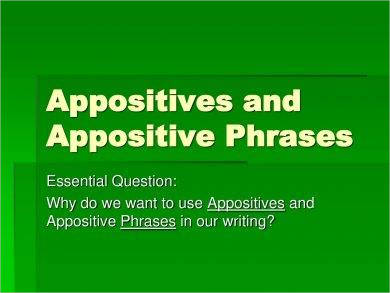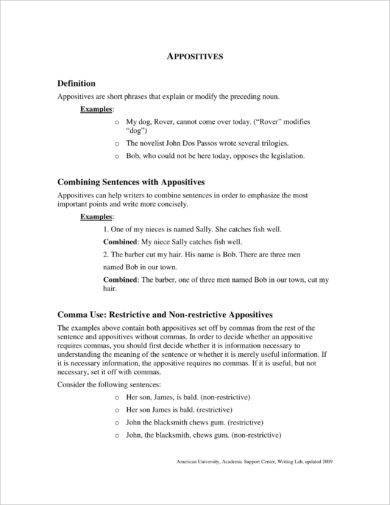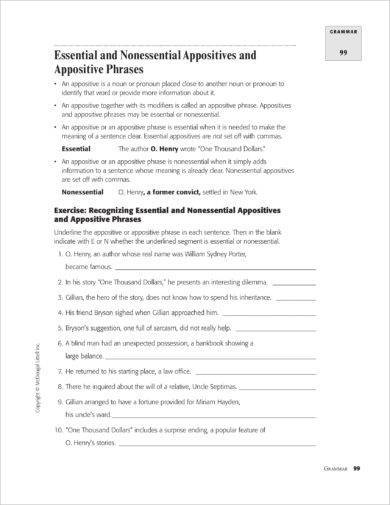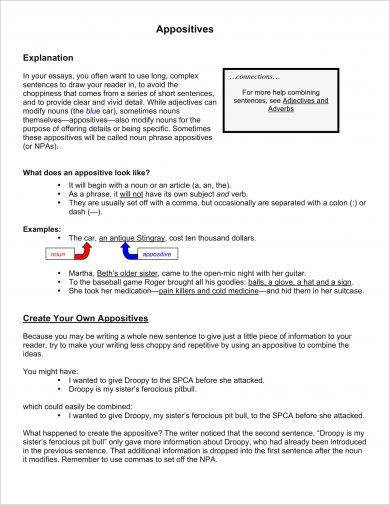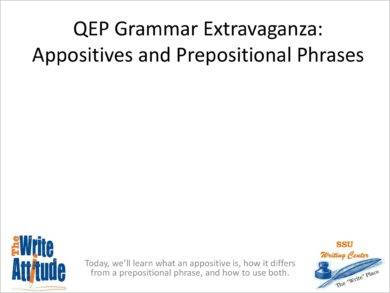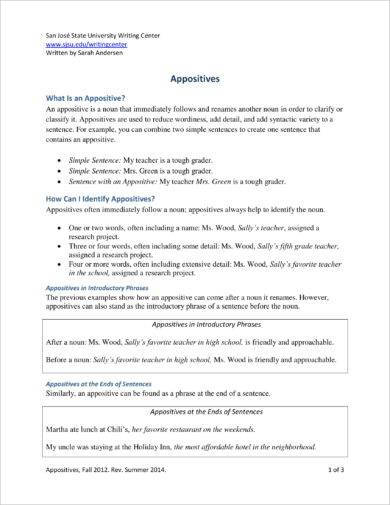9+ Appositive Examples
The variations that you incorporate in a sentence can impact writing activities positively as it gives more interest to the readers especially when it comes to the discussion rhythm that you would like to present. One of these sentence variations is an appositive. You may also see what do you mean by writing skills?
Appositives can be used in different writing activities, from journal writing up to formal writing. Simply put, an appositive is the word that follows a noun or a pronoun for clearer definition or explanation. Appositives are either a noun or a noun phrase. Commas are commonly used to set off the appositive from the noun or pronoun that it follows.
For you to have more clarity and understanding about the subject matter, we recommend you browse through and download the examples available in this post. Reading the discussion below can also help you a lot when it comes to being aware of how to properly and effectively use appositives for your next writing activity. You may also like what is writing used for?
Syntax of Appositive Relativization Example
Two Types of Appositives Example
Appositives and Appositive Phrases Example
Things to Remember When Using Appositives
Using appositives can sometimes be tricky. However, being knowledgeable on how to effectively use them can give you a step forward if you plan to incorporate appositives in your writing. Here are some of the things that you always have to remember when using appositives:
1. Identify the purpose on why you need to use an appositive. This can help you decide on whether it is really necessary to have an appositive in the sentence. Will you use it to improve your writing style? Do you think that using the appositive can help you explain the thought of the sentence further? Answering these questions can guide you within the decision-making process related to the usage of appositives. You may also see writing templates & examples.
2. Know the kind of writing activity that you are immersed in. As an example, formal letter writing may require you to have appositives that are more business-appropriate or professional in nature. The selection of the appositives that you will use must also be based on the kind of words that you would like to modify depending on the type of writing material that you would like to come up with.
3. Most of us are used to seeing appositives following the noun or pronoun that it modifies. However, keep in mind that appositives can also be found at the beginning as well as at the end of the sentence that you are writing. This will depend on your own writing style and the way that you would like to present your subject discussion within a sentence. You may also like formal writing examples.
4. If the appositive is necessary to be seen by your target readers so they can fully comprehend the meaning of your sentence, then the appositive that you have used needs to be set off with commas or a comma.
5. Even if unnecessary appositives are commonly set off from the entire sentence by using two commas, this is actually not always the case. There are some instances where commas that are used inappropriately can only make the sentence confusing. As an example, an appositive at the beginning of the sentence should only have one comma. You may also check out writing examples in pdf.
Simple Appositives Example
Essential and Non-Essential Appositives and Appositive Phrases Example
Appositive Clauses Example
Benefits of Using Appositives
In letter, document, business, or creative writing, the structure of your sentences and the organization of your words can affect how the discussion will be perceived by your target audience. There are different ways on how you can make your article or any written document more engaging and appealing. You may also see application writing examples.
One of which is the usage of appositives. Here are some of the benefits that you can experience if you will use appositives in your writing activity:
1. Appositives can help you to further explain the noun or the pronoun in which the appositive is used for. With this, you can easily explain or describe the subject of the sentence without being too wordy.
2. Appositives can make it more efficient for you to re-name your subject by adding additional facts that can make the subject more relevant. This is very helpful especially if you want to merge two sentences with the same thoughts and subject matter but you just want to elaborate more on the subject that you have used. You may also like memo writing examples.
3. Appositives allow you to modify the subject based on your likeness. You can use a word or a phrase as an appositive depending on how you would like to restate the subject of the discussion.
4. Appositives can make your discussion more understandable. There are necessary and unnecessary appositives that you can use in varying writing activities. Your discussion can be more relevant with the help of appropriate appositives. You may also check out report writing examples.
Whether you are involved in technical writing or free writing, you have to be aware and knowledgeable on how to fully maximize the usage of appositives. The correct and proper usage of appositives can help you a lot, which is why you have to incorporate appositives accordingly.
Explanation on Appositives Example
Appositives and Prepositional Phrases Example
Tips When Using Appositives in a Sentence
May it be in speech writing or business e-mail writing, using appositives is not appealing to everyone. There are some writers whose writing styles do not necessarily resort to the usage of appositives. However, having the knowledge on how to use appositives can give you benefits and advantages especially if you will be asked to participate in a writing activity where the usage of appositives is necessary.
Listed below are some of the tips that you can refer to if you will use an appositive.
1. It is very important for you to correctly and appropriately punctuate the appositive that you will use in a sentence. With the use of a comma, separate the appositive from the rest of the sentence, whether it is found in end or beginning of the sentence or if interrupts the sentence discussion. This is applicable for appositives that are unnecessary when it comes to comprehending the sentence’s actual and full meaning. You may also see summary writing examples.
2. Do not use appositives just for the sake of having one in your sentence. There is no denying or doubt that appositives can truly be helpful to structure your sentence in a more appealing and/or understandable manner. However, you do not need to make it a part of all your writings especially if its addition to the sentence will not truly result to anything helpful or necessary. You may also like script writing examples.
Be reminded that there will be circumstances where it will be harder for readers to understand the thought of your sentence if an unnecessary appositive is present.
3. Know where to place the appositive in the sentence. Remember that appositives are not only seen in the middle of the sentence. It does not always need to be set off by commas, which means that you have the liberty to put an appositive at the start or at the end part of the sentence depending on the structure that you want to use. You may also check out article writing examples.
4. As a grammar structure in which subjects are restated or defined, it is important for you to select the right kind of appositive that can promote clarity within the discussion. Be selective with the appositives that you will use so you can ensure that it can add value to the sentence especially when it comes to the appropriate and clear presentation of what you would like to discuss. You might be interested in essay writing examples.
Basic Appositive Example
Appositives Example
Planning to Use Appositives for Your Next Writing Activity?
Do you plan to write a travel journal? Or are you in the process of creating an academic essay? No matter what kind of writing activity it is that you will execute, here are some of the things that you need to keep in mind if you have already decided to use appositives for the written document that you would like to complete:
1. Do not forget to use references. It will be easier if you have guides and basic instructions related to the usage of appositives.
2. Always check the appropriate incorporation of the appositive in the entire sentence. This can dictate the proper placement of the appositive within the sentence structure. You may also see informative writing examples.
3. Be mindful of using and placing commas. It is not only the overall sentence structure and the appositive used that matter. Commas are also vital.
With the available examples in this post as well as the guidelines and helpful information that we have discussed, we hope that you will consider using appositives in your next effective writing activity so you can make your sentences more interesting, defined, and understandable through a particular manner.



